Dinner plates play a crucial role in both functionality and aesthetics at the dining table. Beyond their practical use, the shape and style of dinner plates can significantly influence the overall dining experience. Whether you’re hosting a formal dinner party or enjoying a casual family meal, understanding the options available can help you make better choices. In this article, we’ll explore the various shapes of dinner plates, their purposes, and how to select the best ones for your needs.
Why Plate Shape Matters
The shape of a Dinner Plates of Different Shapes goes beyond mere aesthetics. It affects the way food is presented, how easy it is to handle the plate, and even the perception of portion sizes. Here are a few reasons why plate shape is important:
- Food Presentation: Different plate shapes can enhance the visual appeal of a dish.
- Functionality: Some shapes are better suited for specific meals or occasions.
- Storage and Stack ability: Shapes influence how plates are stored in cabinets or dishwashers.
- Portion Control: Studies show that plate shape and size can impact how much people eat.
Common Shapes of Dinner Plates
1. Round Plates
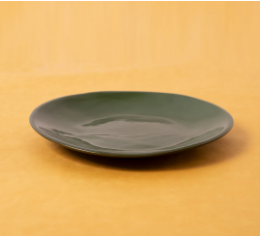
The classic round dinner plate is the most widely used shape. Its simplicity and versatility make it suitable for virtually any setting, from casual meals to formal occasions.
Advantages:
- Easy to stack and store.
- Suitable for a wide variety of cuisines and presentations.
- Available in various sizes and materials.
- Ideal For: Everyday meals, buffets, and formal dining settings.
2. Square Plates
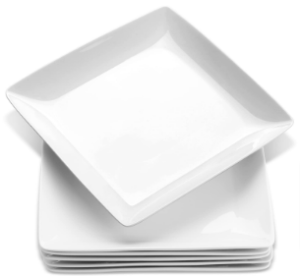
Square plates offer a modern and elegant look, making them a popular choice for contemporary dining experiences.
Advantages:
- Creates a unique visual presentation.
- Maximizes plating surface area.
Disadvantages:
- Can be harder to fit in standard dish racks or cabinets.
- Ideal For: Gourmet meals, modern kitchens, and creative plating.
3. Rectangular Plates
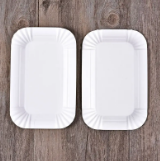
Rectangular plates are often used in fine dining establishments and for serving specific dishes like sushi, appetizers, or desserts.
Advantages:
- Perfect for showcasing long or layered dishes.
- Adds a professional and sophisticated touch.
Disadvantages:
- Limited versatility compared to round or square plates.
- Ideal For: Appetizers, desserts, and specialty dishes.
4. Oval Plates
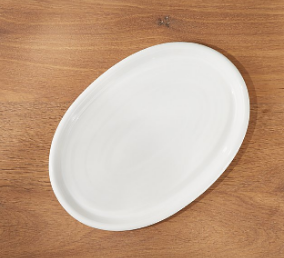
Oval plates provide a balance between round and rectangular shapes, offering a unique yet practical design.
Advantages:
Great for serving family-style meals.
- Accommodates larger portions or irregularly shaped foods.
- Ideal For: Roast dinners, fish dishes, and sharing platters.
5. Triangular Plates
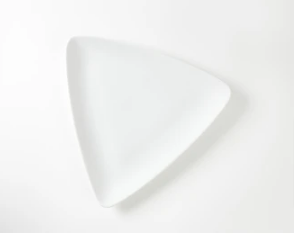
Triangular plates are unconventional and often used to make a bold statement in table settings.
Advantages:
- Creates an artistic and modern aesthetic.
- Ideal for showcasing minimalist or geometric plating styles.
Disadvantages:
- Limited surface area and less practical for everyday use.
- Ideal For: Fine dining, appetizers, and specialty dishes.
6. Asymmetrical Plates
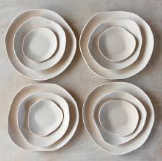
Asymmetrical plates are an avant-garde choice for those looking to push the boundaries of traditional dining aesthetics.
Advantages:
- Highly creative and unique.
- Perfect for artistic food presentations.
Disadvantages:
- May be challenging to store and handle.
- Ideal For: High-end restaurants and special occasions.
- Factors to Consider When Choosing Plate Shapes
1. Occasion
Formal events often call for classic shapes like round or square plates.
Casual gatherings can embrace playful or unconventional shapes.
2. Tableware Compatibility
Ensure that the shape complements other tableware, such as bowls, glasses, and cutlery.
Matching or contrasting shapes can create an appealing aesthetic.
3. Dishwasher and Storage
Some shapes, like round plates, are easier to store and clean.
Unique shapes may require special care or additional storage space.
4. Material
- Ceramic and porcelain plates are versatile and available in various shapes.
- Glass and melamine plates are lightweight and often used for outdoor settings.
- Stoneware and earthenware plates offer rustic charm and durability.
Latest Trends in Dinner Plate Shapes
1. Eco-Friendly Designs
Sustainability is a growing trend, with many opting for biodegradable or recycled materials in unique shapes.
2. Minimalist and Monochrome Themes
Modern dining often leans towards simple shapes like round or square plates in neutral colors.
3. Mixed Shapes and Sizes
Combining different plate shapes in a single table setting creates a dynamic and eclectic look.
4. Artisanal and Handmade Plates
Irregular and asymmetrical shapes crafted by hand are gaining popularity for their uniqueness and authenticity.
Tips for Maintaining Your Dinner Plates
- Proper Storage: Stack plates carefully to avoid chipping, especially for unconventional shapes.
- Cleaning: Follow manufacturer guidelines to maintain the quality of materials and finishes.
- Handling: Handle unique shapes with extra care to prevent breakage.
Conclusion
The shape of your dinner plates can transform the dining experience, blending functionality with aesthetics. Whether you prefer the timeless appeal of round plates, the modern edge of square designs, or the artistic flair of asymmetrical styles, there’s a plate shape for every taste and occasion. By considering factors like occasion, compatibility, and storage, you can select the perfect dinner plates to enhance your meals and impress your guests.
Investing in a variety of plate shapes not only elevates your table settings but also allows for creative expression in food presentation. Explore the latest trends, experiment with different styles, and enjoy the art of dining with the perfect dinner plates.
